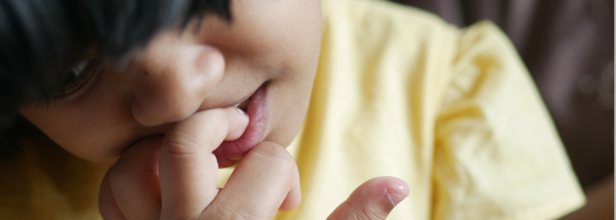- Health Conditions A-Z
- Health & Wellness
- Nutrition
- Fitness
- Health News
- Ayurveda
- Videos
- Medicine A-Z
- Parenting
- Web Stories
What Triggers Nail Biting And Thumb Sucking In Children And How To Stop

Image Credit: Canva
Nail biting and thumb sucking are common habits in children, which are often seen in their formative years. Though these behaviors may seem harmless at first glance, they can have long-term implications for a child's physical and emotional well-being if left unaddressed. Understanding the underlying triggers and effective interventions can empower parents to help their children overcome these habits.
Children bite their nails or suck their thumbs for a variety of reasons, from mere curiosity to stress relief. Nail biting, often referred to as a "nervous habit," can also be due to imitation or boredom. According to Dr. Janaki Ballava Pradhan, Senior Consultant Paediatrics, "Oral habits like thumb sucking and nail biting are common in infants under the age of one, with about 80-90% of children developing these habits at some point in their lives."
Babies have natural sucking reflexes, which is why thumb sucking often starts in infancy. It gives comfort and helps babies soothe themselves, especially during stressful situations or as they fall asleep. However, this soothing behavior can develop into a habitual action that persists into later childhood, particularly in moments of anxiety or boredom.
Health Implications of Nail Biting and Thumb Sucking
Although nail biting and thumb sucking seem innocuous, they can pose many health issues. For example:
- Dental Issues: Thumb sucking for an extended period leads to dental malocclusion or misalignment of teeth. This also affects jaw and palate development, resulting in speech difficulties.
- Infections: Nail biting predisposes the nail beds to bacterial infections and may introduce harmful germs into the mouth, which may cause illnesses.
- Psychological Health: Long-term thumb sucking may lead to psychological problems, such as anxiety or problems in socialization.
- Ear Infections: Research has shown that children who engage in these habits are more likely to experience ear infections due to the presence of bacteria in the ear canal.
Pacifiers, another widely used comfort item, have risks of their own. While they are known to lower the incidence of SIDS in newborns, their use can interfere with breastfeeding and also cause nutritional and immune issues.
If your child engages in unconscious nail biting or thumb sucking due to stress, it could be a way of dealing with their emotions rather than a reason for concern. However, if the same habits turn excessive and become harmful physically or hinder his daily life, then something needs to be done.
Dr. Pradhan underlines that "parents should monitor these habits closely and intervene early to prevent potential long-term health and psychological problems."
How to Stop Nail Biting and Thumb Sucking
1. Positive Reinforcement
Praise your child for not engaging in these habits and reward their progress. For instance, you can set achievable goals, such as avoiding thumb sucking for an hour before bedtime, and reward them with stickers, extra playtime, or a favorite activity.
2. Identify Triggers
Knowing what causes your child to act out is essential. If the stressor is stress, find out what's causing the stress and offer comfort with a hug, reassuring words, or distract with a favorite toy.
3. Soft Reminders
For children who unconsciously develop the habit of biting their nails or sucking their thumbs, gentle reminders can enable them to recognize and desist from the behavior. Avoid scolding or criticism because this increases anxiety levels and reinforces the habit.
4. Consult a Dentist or Pediatrician
If it impacts your child's oral health, take him or her to a dentist. A professional can explain the effects of such practices better than a parent's advice. Sometimes, orthodontic appliances may be prescribed to make sucking painful.
5. Behavioral Techniques
Add behavioral interventions, like using sticky band-aids on thumbs or a bitter nail polish to discourage nail biting. These methods are deterrents without being overly punitive.
6. Build a Supportive Environment
Talk openly with your child so they feel safe. If the nail biting or thumb sucking is due to anxiety, providing a stress-free environment will help eliminate the underlying cause.
What If Nothing Works?
Some children are very hard to break when it comes to these habits. Dr. Pradhan advises against forcing too much on the children, but instead, the parents have to create a positive supporting atmosphere that gradually changes with time.
Extreme cases, however, may seek professional attention, such as counseling or even behavioral therapy, to resolve persistent habits.
Need for Early Intervention
Some habits like nail biting and thumb sucking are common in children. However, they should not be ignored. Early intervention will help prevent potential health and psychological issues, thus helping children grow and develop in a healthy environment.
As Dr. Pradhan concludes, "These habits, although seemingly innocent, can have far-reaching implications if not addressed early. Parents play a pivotal role in helping their children overcome these behaviors through understanding, patience, and appropriate interventions."
Dr. Janaki Ballava Pradhan is a Senior Consultant Paediatrics at Manipal Hospital, Bhubaneswar in India
Punishing Your Children Could Be Harming Their Health: WHO

Credits: Canva
A new report from the World Health Organization (WHO) has shed light on a troubling reality: corporal punishment remains widespread and continues to cause serious harm to children’s health, learning, and overall development.
Despite global progress in child protection laws, millions of children still face physical punishment both at home and in schools.
The Alarming Numbers
Globally, an estimated 1.2 billion children between the ages of 0 and 18 are subjected to corporal punishment in their own homes each year. The data is stark. Across 58 countries, around 17% of children who had recently experienced corporal punishment reported being subjected to its most severe forms. These included being hit on the head, face, or ears, or being struck hard and repeatedly.
The practice varies greatly from country to country. Among children aged 2 to 14 years, self-reported rates by parents and caregivers showed a wide range. In Kazakhstan, about 30% admitted to using corporal punishment in the past month, while in Ukraine the number was 32%. At the higher end, the figures climb to 63% in Serbia, 64% in Sierra Leone, and 77% in Togo.
Also Read: Decoding Baby Cries: What Are They Really Saying?
Schools Are Not Exempt
The troubling reality does not end at home. Schools, where children are supposed to feel safe, are also common settings for corporal punishment. Across parts of Africa and Central America, roughly 70% of children face some form of physical punishment during their school years.
In contrast, the Western Pacific region reports lower rates, but still around one in four children experience it in educational settings.
No Benefits, Only Harm
Experts stress that corporal punishment offers no benefits for children, families, or societies. Etienne Krug, Director of the WHO Department for Health Determinants, Promotion and Prevention, emphasizes that the evidence is now overwhelming.
Corporal punishment places children at multiple risks without improving their behavior, development, or well-being. Instead, it undermines their growth and creates lasting damage.
Who Is Most at Risk?
The report, Corporal Punishment of Children: The Public Health Impact, points out that some groups of children are more vulnerable than others. Those with disabilities, children of parents who themselves experienced corporal punishment, and those whose parents struggle with mental health issues or substance abuse face higher risks.
Larger societal factors, including poverty, racism, and discrimination, also play a significant role in perpetuating the cycle of violence.
Long-Term Health and Developmental Consequences
The effects of corporal punishment are far-reaching. Beyond immediate injuries, it alters children’s biological responses. Repeated punishment has been linked to higher stress hormone levels and even changes in brain structure and function, which can hinder healthy growth.
In low- and middle-income countries, data show that children exposed to corporal punishment are 24% less likely to be developmentally on track compared to their peers.
The psychological impact is equally concerning. Anxiety, depression, low self-esteem, and emotional instability are commonly seen in children who endure such punishment. Unfortunately, these issues often continue into adulthood, contributing to higher rates of depression, substance abuse, and even suicide.
A Broader Impact on Society
The damage is not confined to individual children. On a societal level, corporal punishment can normalize violence.
Children who experience it are more likely to struggle in school, adopt aggressive behaviors, and as adults, engage in antisocial or criminal conduct. The ripple effects create a dangerous cycle of violence across generations.
Moving Beyond Legislation
While many countries have enacted laws banning corporal punishment, the practice persists. This shows that legislation alone is insufficient. WHO stresses that legal reforms must be paired with awareness campaigns, parental support programs, and training for teachers. Promoting positive, non-violent approaches to discipline is key to breaking this cycle.
Jana Duggar Announces Pregnancy At 35, Here's What New Mothers In Their 30s Should Pay Attention To

Credits: Instagram
Jana Duggar, 35, days after celebrating her first wedding anniversary with her husband Stephen Wissmann, announced that they are expecting their first baby. The 19 Kids and Counting star said that the baby is expected to arrive in January 2026 and that the couple is "counting down the days and eagerly looking forward to this thrilling new chapter".
As Duggar looks forward to this new chapter in her life, it does raise an important question: How safe is it to have your baby after 30?
As per the National Institute of Health (NIH), US (2022), 20% of women in the US are now having their first child after the age of 35. While it is the new trend, the NIH doctor Dr Alan Decherney, a fertility expert explains that "As women age, they are still fertile, but their odds of pregnancy are decreased because they are not making as many good eggs that will fertile and divide normally and turn out to be an embryo."
ALSO READ: Women Are Now Waiting More Before Becoming A Mother, Age Trend Shows Motherhood From 2016 to 2023
Is Getting Pregnant More Difficult After 30?
After age 30, a woman's fertility decreases ever year, notes the NIH July 2022 issue. It notes: "The number and quality of her eggs goes down until she reaches menopause."
However, experts do point out that getting pregnant in your 30s need not be a stressful affair at all times. As it is at this age when you experience more stability, and also someone you know who have a personal experience in handling one. Most important, you are more mature at this age, which you may not be in your 20s.
ALSO READ: Baby Born From 30-Year-Old Frozen Embryo Sets Record: Here's All That We Know About It
Are You Planning Your Pregnancy After 30s? Here's How To Do It Right
Quit Habits: If you are a smoker, or consume alcohol, this is a good time to leave it.
Reduce Stress: While pregnancy for some can bring stress, try to find activities that help you release it.
Healthy Weight: Ensure that your weight is right, reduce your waist to bring it to a healthy range for a healthy pregnancy.
Food Habits: Stop eating junk and start eating more whole grains.
Exercise: A sedentary lifestyle can impact negatively on the child. You do not have to do HIIT, however, regular easy workouts can make both the pregnancy and delivery easy.
What Women In Their 30s Should Be Ready For During Pregnancy?
Dr Michelle Y Owens, professor of obstetrics and gynecology and a practicing maternal-fetal medicine specialist at the University of Mississippi Medical Center in Jackson, writes for the American College of Obstetricians and Gynecologists (ACOG) that "the longer your eggs have been around, the more likely they are to produce a pregnancy with a chromosome problem that can lead to a condition like Down syndrome. The risk goes up significantly after 35."
However, she says, there is a good news. Now, we have tools to detect and respond to pregnancy complications early.
READ: Expecting? Here's What The New Gestational Diabetes Testing Rules Mean For You
Why First Trimester Is Important For You And Your Baby?
As per the Johns Hopkins Medicine, your first prenatal visit is the most thorough, this is when your complete medical history is taken, physical examination is done and certain tests and procedures are performed to assess the health of both you and your child.
This is also the time when the fetus is most susceptible to damage from substances like alcohol, drugs and certain medicines, and illnesses like rubella, thus this is the most crucial time for the parents. First trimester is also the time when the baby undergoes a lot of development, while it may not be seen from the baby bump, however, the amniotic sac, placenta and the umbilical cord are all developed during this stage.
Since a lot of development happens during this stage, Dr Owens notes that this is why having a prenatal screening test during the first trimester helps you understand your baby's development and if your baby is at risk for any genetic disorders. "More frequent ultrasounds can measure the growth of the fetus and also look for birth defects. We’ll check your blood pressure at every prenatal visit, and we'll test you for gestational diabetes too. Early diagnosis plus treatment creates the formula for the best possible outcomes," she writes.
Paracetamol During Pregnancy Could Cause Neurodevelopment Disorders In Newborns – Study

(Credit-Canva)
Pregnancy is a sensitive and difficult time for expectant mothers. They must be careful about what they eat and how long they are active. It is also advisable for them to avoid certain medications, unless they have been prescribed by a doctor. As you may know, what the mother consumes will eventually affect the child, so while something that the mother can handle can be fatal to the child as it is at a very vulnerable stage. As such, a few studies have suggested that consuming medications like paracetamol can affect the child’s brain.
A new study published in the BioMed Central suggests that taking paracetamol (also known as acetaminophen) during pregnancy might be linked to a higher risk of autism and ADHD in children. This is a significant finding because paracetamol is a very common over-the-counter medicine that many pregnant women take for headaches, pain, or fever.
Researchers from the Icahn School of Medicine at Mount Sinai looked at 46 past studies involving more than 100,000 people. They found that the better-quality studies were more likely to show a connection between using paracetamol during pregnancy and a child's risk of developing these disorders.
How Does Paracetamol Affects Pregnancy And The Baby?
The researchers believe there could be a biological reason for this connection. They explain that when a pregnant person takes paracetamol, the medicine can cross from their body to the baby. Once there, it might cause stress to the baby's cells, mess with their hormones, and even change how their genes behave. These changes could interfere with the normal development of the baby's brain.
Since the number of autism and ADHD cases seems to be increasing around the world, these findings are very important. They could change how doctors and health officials think about the use of this common drug during pregnancy.
Should Pregnant Women Take Paracetamol For Pregnancy?
It's important to remember that this study does not prove that paracetamol directly causes autism or ADHD. However, the evidence is strong enough to raise concerns about how much it's being used.
Because of these findings, the study's authors suggest that pregnant women should use paracetamol with caution, for a short period of time, and only under a doctor's guidance. They also say that more research is needed to fully confirm these results and understand the risks.
Is This Accurate For All Children?
While it is ok to be cautious, there are other studies that do not draw the same conclusion. A 2024 study published in the JAMA network found no such link. The study suggested that using paracetamol during pregnancy does not increase a child's risk of developing autism, ADHD, or intellectual disability. This finding goes against some previous studies and is important for managing pain and fever during pregnancy. The study, which looked at over 2.4 million children born in Sweden, found that a direct link could not be made when other factors were considered.
What the Sibling Study Showed
When the researchers compared the siblings, they found no evidence that paracetamol use during pregnancy was linked to a higher risk of autism, ADHD, or intellectual disability.
- The risk for autism, ADHD, and intellectual disability was virtually the same in the exposed and unexposed siblings.
- The study found no connection even when mothers took more paracetamol.
This suggests that the slight link found in the initial analysis was likely due to "confounding factors," meaning other family-related reasons—not the medication itself—were responsible for the difference in risk. For example, a mother with a certain condition that requires her to take paracetamol might also have a genetic trait that affects her children.
In short, this new research provides strong evidence that paracetamol use during pregnancy is not a direct cause of these neurodevelopmental disorders.
© 2024 Bennett, Coleman & Company Limited

